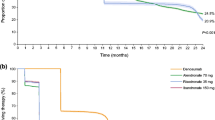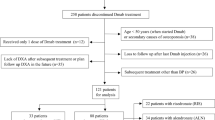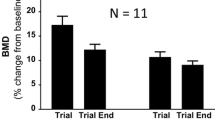Abstract
Summary
Discontinuation of denosumab (Dmab) therapy is associated with lower serum CTX levels in osteoporotic patients previously exposed to bisphosphonates compared to those who were not.
Introduction
Discontinuation of Dmab therapy is followed by a transient increase of bone turnover markers (BTMs) above pretreatment values, together with accelerated bone loss, and potentially an increased risk of multiple vertebral fractures. Since a substantial proportion of patients discontinuing Dmab have previously been exposed to bisphosphonates (BPs), we hypothesized that previous BP therapy could attenuate this increase in bone turnover because of the prolonged biological effects of BPs on bone.
Methods
In a retrospective observation, we assessed serum CTX levels between 7 and 24 months after the last Dmab injection in 37 patients (33 women and 4 men, aged 50 to 84 years). CTX levels were analyzed according to the number of Dmab injections (1 or multiple) and previous exposure to BPs.
Results
In 8 patients who had received only 1 Dmab injection, 7 out of 8 were previously on BPs and none of them showed CTX values above the premenopausal range after Dmab discontinuation. CTX also remained in the premenopausal range in 14 out of 17 patients who discontinued Dmab after multiple (4.1 ± 1.4, range 2–7) injections but were previously exposed to BPs (mean exposure 6.9 ± 5.8 years, range 11 months–15 years; mean time interval between BP exposure and Dmab initiation 25 ± 10 months, range 0–48). In contrast, in 12 patients who discontinued Dmab after multiple (5, range 3–9) injections without prior exposure to BPs, mean CTX levels as measured on average 11.3 months (range 6–23) after the last Dmab injection were above the upper limit of premenopausal range (mean +114%, range 28–320%, p = 0.003–0.005 vs previous BPs).
Conclusion
The higher CTX levels occurring after Dmab discontinuation in patients who have received multiple injections may be prevented by prior exposure to BPs. This observation may be related to the persistent effects of BPs on bone that prevent the resorbing activity of newly formed osteoclasts when RANK Ligand is no more antagonized.



Similar content being viewed by others
References
Cummings SR, San Martin J, McClung MR et al (2009) Denosumab for prevention of fractures in postmenopausal women with osteoporosis. N Engl J Med 361:756–765
Miller PD, Bolognese MA, Lewiecki EM et al (2008) Effect of denosumab on bone density and turnover in postmenopausal women with low bone mass after long-term continued, discontinued, and restarting of therapy: a randomized blinded phase 2 clinical trial. Bone 43:222–229
Brown JP, Roux C, Törring O et al (2013) Discontinuation of denosumab and associated fracture incidence: analysis from the fracture reduction evaluation of denosumab in osteoporosis every 6 months (FREEDOM) trial. J Bone Miner Res 28:746–752
McClung MR, Wagman RB, Miller PD et al (2017) Observations following discontinuation of long-term denosumab therapy. Osteoporos Int. doi:10.1007/s00198-017-3919-1
Aubry-Rozier B, Gonzalez-Rodriguez E, Stoll D et al (2016) Severe spontaneous vertebral fractures after denosumab discontinuation: three case reports. Osteoporos Int 27:1923–1925
Popp AW, Zysset PK, Lippuner K (2016) Rebound-associated vertebral fractures after discontinuation of denosumab—from clinic and biomechanics. Osteoporos Int 27:1917–1921
Anastasilakis AD, Makras P (2016) Multiple clinical vertebral fractures following denosumab discontinuation. Osteoporos Int 27:1929–1930
Lamy O, Gonzalez-Rodriguez E, Stoll D et al (2016) Severe rebound-associated vertebral fractures after denosumab discontinuation: nine clinical cases report. J Clin Endocrinol Metab. doi:10.1210/jc.2016-3170
Anastasilakis AD, Polyzos SA, Makras P et al (2017) Clinical features of 24 patients with rebound-associated vertebral fractures following denosumab discontinuation: systematic review and additional cases. J Bone Miner Res. doi:10.1002/jbmr.3110
Brown JP, Ferrari S, Gilchrist N. Discontinuation of denosumab and associated fracture incidence: analysis from FREEDOM and its extension. ASBMR, Atlanta 16–19 sept 2016, abstract 1100
Black DM, Schwarz AV, Ensrud KE et al (2006) Effects of continuing or stopping alendronate after 5 years of treatment: the Fracture Intervention Trial Long-term Extension (FLEX): a randomized trial. JAMA 296:2927–2938
Black DM, Reid IR, Cauley JA et al (2015) The effects of 6 versus 9 years of zoledronic acid treatment in osteoporosis: a randomized second extension to the HORIZON-Pivotal Fracture Trial (PFT). J Bone Miner Res 30:934–944
Papapoulos SE, Cremers S (2007) Prolonged bisphosphonate release after treatment in children. N Engl J Med 356:1075–1076
Bekker PJ, Holloway DL, Rasmussen AS et al (2004) A single-dose placebo-controlled study of AMG 162, a fully human monoclonal antibody to RANKL, in postmenopausal women. J Bone Miner Res 19:1059–1066
Thiebaud D, Burckhardt P, Kriegbaum H et al (1997) Three monthly intravenous injections of ibandronate in the treatment of postmenopausal osteoporosis. Am J Med 103:298–307
Author information
Authors and Affiliations
Corresponding author
Ethics declarations
Conflicts of interest
BU received consulting fees from Amgen, Eli Lilly, and MSD. RR received fees for advisory board or lectures from Danone, Labatec, Nestlé, ObsEva, and Radius Health. SF received consulting fees from Agnovos, Amgen, Eli Lilly, MSD, Radius Health, and UCB.
Rights and permissions
About this article
Cite this article
Uebelhart, B., Rizzoli, R. & Ferrari, S.L. Retrospective evaluation of serum CTX levels after denosumab discontinuation in patients with or without prior exposure to bisphosphonates. Osteoporos Int 28, 2701–2705 (2017). https://doi.org/10.1007/s00198-017-4080-6
Received:
Accepted:
Published:
Issue Date:
DOI: https://doi.org/10.1007/s00198-017-4080-6




